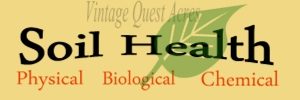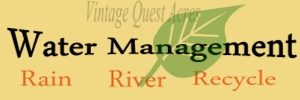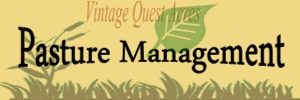There are quite a few things we do at VQA that may be common to the ‘crunchy’ few and unusual to many ‘conventional’ others. Some things may have been common ideas in the past and some things may be innovative.
Here are a few examples:
 The biological health of the soil is maintained by encouraging beneficial flora and fauna, allowing poultry and ruminants to forage after crops are harvested, rotating crops, using multiple grass types in pasture and not using any pesticides or herbicides.
The biological health of the soil is maintained by encouraging beneficial flora and fauna, allowing poultry and ruminants to forage after crops are harvested, rotating crops, using multiple grass types in pasture and not using any pesticides or herbicides.
The chemical health of the soil is maintained by the manufacture and addition of large amounts of compost which stabilizes the pH and moisture content and by not adding toxic pesticides.
At VQA we manage the soil’s physical health by:
• limiting compaction by the tractor
• reducing erosion by: never leaving exposed soil, terracing slopes used for crops, and digging trenches to manage water during infrequent sustained heavy rainfalls
• adding mature compost made from horse manure, hay, wood chips, household kitchen scraps and coffee collected from coffee shops.
• using mixed grasses in pastures, rotating crops in fields and maintaining a natural forest
• promoting worms
• tilling in plant materials such as compost, weeds and crop residues
World-wide staggering amounts of toxic chemicals are poured onto farm soil. These poisons are designed to kill life and persist in the soil long after the crop is harvested. Over time the levels of toxin accumulate in the soil, change the pH and destroy the natural interaction of flora and fauna that plants evolved to thrive in. The most common form of soil pollution is a group of pesticides which include insecticides, rodenticides, herbicides, algicides, fungicides and bactericides. These total an estimated 5.6 billion pounds each year.
Since 1960, an estimated 1/3 of the world’s arable land has been lost to erosion and other degregation.
 Rain water is collected from every building on the farm. It is stored in tanks connected to a system of buried pipes for use in irrigation, the greenhouse and to water the livestock. Rainwater is also caught in ponds dug into ‘low spots’ in pasture fields for use by livestock. This system is the main source of on-demand water for the farm.
Rain water is collected from every building on the farm. It is stored in tanks connected to a system of buried pipes for use in irrigation, the greenhouse and to water the livestock. Rainwater is also caught in ponds dug into ‘low spots’ in pasture fields for use by livestock. This system is the main source of on-demand water for the farm.
Spring-fed river water is used for livestock and can be used through a pump-house for irrigation if ever a sustained drought exhausts the stored rain water. Not using toxic chemicals eliminates runoff pollution in water ways.
Grey and black water are used to generate natural gas and then flow into a fenced off area of native wetland plants which provide habitat for beneficial insects. Once ‘nature cleaned’, the recycled water filters down into the water table.
The greenhouse has 1600 gal of water which includes an aqua-ponics system. The water serves as thermal mass to stabilize the temperature, as a heat source through a spray system, as the space where fish are grown and the space where vegetables are grown to clean the fish water. The greenhouse water can be replaced by stored rainwater and pumped to the crop fields.
Agriculture uses 70% of the world’s accessible fresh water.
 At VQA we keep bee hives and protect native pollinators by refusing to use pesticides. Additionally we have a forest and produce a wide variety of crops that provide pollen from spring through fall.
At VQA we keep bee hives and protect native pollinators by refusing to use pesticides. Additionally we have a forest and produce a wide variety of crops that provide pollen from spring through fall.
Pollinators are crucial to more than 2/3 of the world’s crop species, yet bee and butterfly populations are in serious decline. Although denied by the people who sell the chemicals designed to kill insects (like bees), these chemicals and the practice of mono-culture (growing just one crop on a farm) have directly caused the pollinator crisis. Did you know that up to 70% of pollination is done by native species not honey bees? When a farm is mono-culture the pollen is only available once a year – this starves away native and managed pollinators. This practice has resulted in bee keepers shipping their hives around the country on trucks and feeding them sugar water between flowering periods. Old fashioned, diversified farms and forests have pollen all year.
 • Mixed grasses with varieties that flourish in each season, add nitrogen and pull nutrients from different levels.
• Mixed grasses with varieties that flourish in each season, add nitrogen and pull nutrients from different levels.
• Mob-grazing – forcing animals to eat least favorite plants thereby preventing weed explosion.
• Including fowl with cattle to spread manure and eat pests.
• Goats, hogs, turkeys, ducks, chickens and cattle together to eat different plants.
• No spraying, hand weeding every few years.
• Smaller livestock do less damage to wet pasture.
 We use the greenhouse for many things. Among them:
We use the greenhouse for many things. Among them:
• Growing tropical fruit • Aqua-ponics • Home heating • Goat/chick nursery • Summer crops all year • Starting seedling • A fun place to relax • Many herbs • Mushrooms • Fish
For more information on the greenhouse go here.
 Pasturing our animals is not the easy way but it is the right way. It takes a lot of space, money and time to maintain grassy fields for all the poultry and grazers.
Pasturing our animals is not the easy way but it is the right way. It takes a lot of space, money and time to maintain grassy fields for all the poultry and grazers.
Eggs
Did you know that 60% of an egg laying hen’s diet is grass/fresh greens when given the choice. That is why pastured eggs are between $9 and $12 a dozen! If you pay less than that your eggs most likely came from a factory farm with the birds stuffed close quarters on concrete floors deep in poop and choking toxic excretion fumes. The TV adverts and packaging are not truthful.
Beef and Goat
The meat animals are free ranged and never get grains. Why Grass-fed?
Dairy
The dairy does and cows only get grain as a reward while milking, otherwise it is grass and leaves they forage.
Hay Feeder
Hay is used in winter to supplement the pastures. Only the winter wheat mixed into teh field grasses grows in winter but not enough to feed the animals without grasses saved from summer. This photo shows an innovative hay feeder I made to reduce waste common when using large round 4’x5′ bales of hay.
Mini-Milkers
I have developed a small triple purpose cow with A2 and grass genetics. They are easy to manage, gentle on pasture and infrastructure, can thrive on poorer forage and are hardy to weather and parasites. More information here.
Livestock Guardian Routes
These ‘gateways’ allow the livestock guardian dogs to move from field to field without the livestock being able to do so too.
 We have many fruits: 6 apple varieties, cherry, 2 pear varieties, peach, 2 fig types, plums, Kentucky Coffee trees, mulberry, black berry, raspberry, dew berry, persimmon, 6 grape varieties, strawberry, blueberry, apricot, nectarine, pomegranate and chestnut.
We have many fruits: 6 apple varieties, cherry, 2 pear varieties, peach, 2 fig types, plums, Kentucky Coffee trees, mulberry, black berry, raspberry, dew berry, persimmon, 6 grape varieties, strawberry, blueberry, apricot, nectarine, pomegranate and chestnut.
Livestock are used in the orchard and vineyard to control the grass and weeds. The accessible fruit vines and trunks are protected from the grazing.
To reduce fungus, mold, disease and pests the vineyard is covered. A sketch of the design is here. This allows for chemical free crops which is very unusual. Water from the vineyard cover is used for irrigation.
 We grow vegetables in all 4 seasons using well drained fields and the greenhouse in winter.
We grow vegetables in all 4 seasons using well drained fields and the greenhouse in winter.
• Using a low area near the creek and dam we can grow rice with water level control
• Walk-in coolers: earth sheltered and under a water tower.
• Kitchen worm-composting for greenhouse
• Composting for farm vegetable fertilization. Collect horse manure and wood chips in dump truck from local business, mix with farm waste and Starbucks coffee ground.
• Natural insect predators
• Alternating fields to allow livestock to ‘clean-up’ after harvest
• Multiple crops to reduce pest pressure and help pollinators
• Not using plastic ground cover for weed/pest control and not using disposable packaging reduces landfill waste.
Organic Certification
USDA Certified Organic is a good thing for when you don’t know your farmer. It provides a minimum level of comfort in the food you are about to eat when you don’t really know anything about it.
Organic Standards Basics
Soil and plants cannot be treated with chemicals or persistent pesticides or herbicides.
No synthetic fertilizers or sewage sludge can be used to promote growth.
GMOs are not allowed.
Animals are fed organic feeds, given access to the outdoors, and allowed to fulfill their natural behaviors.
Synthetic growth hormones and antibiotics are forbidden.
Organic certification does not address all the issues you should know such as: where the food came from, how it was produced, who produced it, how many people have touched it, how long it was since harvest, how many times has it been transferred and stored, its carbon footprint, the waste and water management impact for each farm, middleman and vendor, if the product has material mixed from multiple locations, the legality and fairness with respect to workers all along the supply chain and the beliefs and practices of the people involved in getting it to you.
As a thought, I went through the USDA certification process with another, larger farm I had once. I know that the requirement are not 3rd party checked on a timely basis, they are on the self-reporting, honor system. Also, for foreign produce labeled USDA Organic – how often do you think actual USDA official inspect those farms? Still, its much better to buy organic before buying conventional industrial food. Many studies have found Organic food superior. In one study, from 236 scientifically valid “matched pairs” of organic and conventional foods, the organic foods were nutritionally superior in 67% of the cases, vs. 37% for conventional.
It amazes me that people have willingly allowed big corporations to create this new norm where they blindly buy industrial food without any knowledge of it, without regard to their health or the health of the environment.
VQA does not need to be certified organic – it would be a step down. We already exceed those standards.